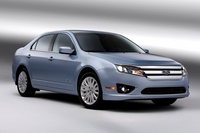2010 Ford Fusion Hybrid Review
DON'T MISS: Compare Ford, Toyota, Nissan and Honda Hybrids
DON'T MISS: Ford Specs, Prices and Reviews-Ford Buyers Guide
THE AUTO PAGE
By
JOHN HEILIG
2010 FORD FUSION HYBRID SPECIFICATIONS
Model: 2010 Ford Fusion Hybrid
Engine: 2.5-liter I-4 plus 106 hp permanent magnet AC
synchronous motor
Horsepower/Torque: 171 (net) @ 6,000 rpm/ 136 lb.-ft. @ 4,500
rpm
Transmission: Electronic CVT
Wheelbase: 107.4 in.
Length/Width/Height: 190.6 x 72.2 x 56.9 in.
Tires: P225/50 R17
Cargo volume: 11.8 cu. ft.
Fuel economy: 41 mpg city/36 mpg highway/38.9 mpg test
Fuel capacity: 17.0 gal.
Sticker: $33,210 (includes $725 destination and delivery
charge and $5,215 in options)
The Bottom Line: One of the more practical hybrids around, the Fusion offers mid-size car roominess for four passengers and outstanding economy without screaming "hybrid" at every other car and driver on the road.
You gotta like hybrids, even if you don't like them.
For example, the first hybrid to hit the US shores was the Honda Insight. This overly aerodynamic two-seater sure looked different. Driving down the road we got stares from other drivers and we always had to roll down the windows at stop signs to explain it to others.
Toyota's Prius is, arguably, the most successful hybrid. But it, too, looks slightly strange. You know one when you see one, and the owners all have these smug looks on their faces as if to say "I'm special. Look what I'm doing for the environment." The fact that one-passenger Priuses can go in HOV-2 lanes doesn't hurt either. The Prius is good for 35-40 mpg in normal driving, but the rear seat is still compact-car size, which isn't fun for senior citizens.
But there are those of us who aren't looking for sainthood and expecting "normal car" drivers to bow down to us as we pass. While we appreciate the virtues of hybrids, we don't necessarily like the sacrifices we're asked to make.
The first "normal" hybrid we encountered was the Ford Escape Hybrid, which got an honest 30 mpg over all kinds of roads (compared to about 20 for the straight gasoline version) and didn't advertise its hybridness all over the place. As a bonus, it also offered the virtues of a compact 2WD SUV, with the added cargo capacity over sedans and coupes.
What we have now is even better - the Ford Fusion Hybrid. Except for the ice blue exterior color of the test Fusion, and a couple of badges tastefully applied to the exterior, this looks almost normal. Even sitting behind the wheel, it drives like a standard Fusion, yet we averaged - get this - 38.6 mpg over Interstates and suburban roads, with a short stretch into the city.
The Fusion, with its 155 hp 2.5-liter inline four engine supplemented by a 106 hp electric motor, has adequate power. I wouldn't expect Matt Kenseth to drive one of these at Daytona, but you get the idea. Our test car had an electronic Continuously Variable Transmission that was smooth and had no noticeable shift points.
Even the instrument panel is almost normal. There's a 120 mph speedometer in the center. To the left is a Power/EV gauge to indicate the power being applied by the gasoline or electric motor. Next to that is a battery information gauge giving you an idea of the energy still remaining in the battery.
To the right of the speedometer is an instantaneous mpg gauge. Normally, I hate these things because you really don't get an idea of how economically you're driving. But with this one, you're pretty certain that when the needle rises to the top (60 + mpg) you're dong well. To the right of this is an overall mpg gauge on the top and miles to empty on the bottom. In the middle are "efficiency leaves," the most gimmicky part of the dash. If you have more leaves in the display, you're driving economically, fewer leaves and you're a bad boy (or girl).
What is most intriguing is that when you shut down, this area gives true trip computer date. It tells you miles traveled on your trip (for example, it's 220 miles from my house to Penn State, 1.4 miles to my daughter's house) MPG on the trip, gallons of fuel used (4.4 gallons to Penn State, .1 gal to my daughter's), and at the bottom, overall mpg.
Being a techie, I liked this part of the display best. There are different settings available by playing with the options buttons, but I liked the factory settings on the Fusion as I got it. There are some sacrifices. For example, the trunk capacity is only 11.8 cubic feet versus 16.5 in the standard Fusion. The gas tank is a bit smaller as well, but since you don't use as much gas anyway, that doesn't matter.
The Fusion Hybrid had a sticker price of $33,210 with a $27,270 base. The only option ($5,215) was a package including a voice-activated navigation system; Blis with cross traffic alert that warned, via a light in the outside rearview mirror, of cars in your blind spot; rear view video camera with an excellent color screen readout; power moonroof; Sony sound system; and leather-trimmed heated front seats.
And when you go to fill up, the Fusion also comes equipped with Ford's Easyfill capless filler, which is great.
© 2009 The Auto Page Syndicate



